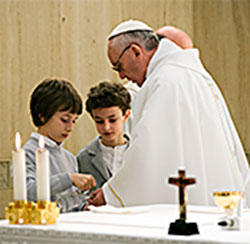 The photo on the left, of Pope Francis Saturday morning, 20 April, presiding at Mass in the chapel of the Domus Sanctae Marthae, has been doing the rounds.
The photo on the left, of Pope Francis Saturday morning, 20 April, presiding at Mass in the chapel of the Domus Sanctae Marthae, has been doing the rounds.
Young lads as servers. Not vested. Simple cross on the altar. Two candles to one side…
Many of those who were disappointed (in disagreement) with the direction that liturgy has been moving in the West since the reform of Vatican II, became enthusiastic about what became called “the Reform of the Reform” – a return to more pre-Vatican II feel, style, and practice. Pope Benedict XVI was their hero, the movement’s leader and prime example.
Ultramontane understanding of the papacy, and catch-cries of “Where Peter goes, we follow” were good covers for what, at a safer distance, look like personal preference and a lot of focus on form over substance.
With the arrival of Pope Francis those same people have significantly lessened their chanting of “Where Peter goes, we follow”. The official end of the Reform of the Reform has been announced. “Reading Francis through Benedict” has become one way for the movement to regroup.
The reform of the reform of the reform has begun.
ps. no prizes for guessing whether my own presiding style is closer to that of Francis or of Benedict.
If you appreciated this post, there are different ways to keep in touch with the community around this website: like the facebook page, follow twitter, use the RSS feed,…



Morning mass at local RC church.
Given that the communal worship in earliest days may have used “Sunday best” but nothing extraordinary Pope dreesed in vestments may be a little extreme .Dressing up is of relevance to our basic needs- well,the needs of many of us- to mark special occasions with special style, eg funeral of Margaret Thatcher. Such behaviour certainly enlivens me. But let us not turn into the necessary as indeed I do not doubt you think. Any how i go to a very dreesed up church- e.g sackcloth in lent, gorgeous pink on Gaudete and Laudate Dundays etc. overdressed acolytes?. But it does separate the sacred from the day to day. When we local Anglicans marche down main street of town all dressed up on Palm Sunday caused an interesting stir and full church. Then we are celebrarating first Sunday in May in local former Trades Hall as our own feast of Christ the Artisan.
There is one sentence at least not well written. I meant to say that I did not doubt that you did not see presiding as prefering form over substance.
I don’t know what the rest of that chapel looks like, but the cross on the altar faces liturgical east for the celebrant’s meditation. It is usual to have a little cross facing east in Catholic masses versus populum. The thinking is that the celebrant should face a crucifix at the altar, and that, with the move to versus populum, a ‘personal’ cross needed to be used as the altar cross would often be behind the celebrant. It’s the case in my chapel: a white marble crucifixion scene forms the reredos, which originally the celebrant would have faced, but, with reorientation, is behind me. I would expect the hostel’s chapel to have either a fixed crucifix or a processional cross that provides the main focus with the altar (interpreting the altar), with the little crucifix serving the celebrant.
I have some sympathy for those who were part of ‘the reform of the reform’, in that the movement is to celebrate and restore the art of liturgy. I particularly appreciate the restoration of the musical art. We can all find elements of what might be termed the overzealous implementation of Vatican II and broader Liturgical Movement that lessen the dignity of worship for some perceived, but often unrealised, idea of approachability.
Simplicity is the key. Knowing what is the bare minimum of what is to be done prevents the muttering of prayers that serve little purpose but turn the page of the prayer book. Each additional element then needs to be interrogated as to what worth it brings.
Dressing down for Mass comes from a false understanding of the Mass and of the Holy Eucharist. It comes from one which at best underplays Christ’s divinity, and at worst denies the Priest being in persona Christi and the real presence of Christ in the Eucharist. Since the earliest days, Christians have always used the very finest in the Sacrifice of the Mass, and it has only been with a false Protestant theology that has entered the Church in the wake of, and in spite of, Vatican II, that we have cheapened the Mass.
Your comments are very interesting, but I’d be reticent at this point to read too much into the presidential style of Pope Francis for the longer term ‘reform of the reform of the reform.’ Only time will tell in what direction the liturgy and its celebration might take under the watch of Francis.
On the other hand, it is nice to see the ‘noble simplicity’ of his presidential style – something I think we could do with more of.
I agree, Andrew, about not reading too much into things. “Noble simplicity” is a lovely description of what I would hope for in my own presiding, and the liturgical style in my book Celebrating Eucharist. Christ is risen.
If a return to “Pre-Vatican II” means a return to “no female servers” – well, that would be a significant step backwards, not forwards, in reform. I would be disappointed.